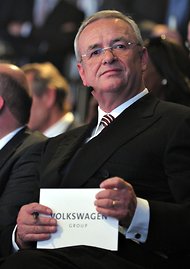Stocks drifted lower on Friday, after closing at fresh record highs a day earlier, as rosy results from JPMorgan and Wells Fargo were offset by a profit warning from United Parcel Service.
In afternoon trading the Standard Poor’s 500-stock index was 0.1 percent lower, the Dow Jones industrial average lost 0.2 percent and the Nasdaq composite was flat.
The S.P. 500 and the Dow closed at record highs on Thursday, after the Federal Reserve chairman, Ben S. Bernanke, said the Fed would keep monetary policy loose for some time to lower the unemployment rate.
JPMorgan Chase, the largest American bank by assets, advanced 0.3 percent after reporting a 31 percent jump in quarterly profit as trading revenue rebounded.
Shares of Wells Fargo, the country’s largest mortgage lender, climbed 2 percent the company reported a higher-than-expected 19 percent rise in quarterly profit.
But United Parcel Service, the world’s No. 1 package delivery company, dropped 5.7 percent. It estimated second-quarter profit would be below analysts’ expectations because of overcapacity in the world freight market. Rival FedEx lost ground too, shedding 2.3 percent.
“Wells Fargo and JPMorgan have come in with better than expected numbers. U.P.S. is probably not a surprise given ongoing downward revisions in guidance,” said Fred Dickson, chief market strategist, D.A. Davidson Company in Lake Oswego, Ore. “We’ll go a little bit higher, consolidate gains, maybe take a little profit going into the weekend and investors are going to sit back and wait for the tidal wave of earnings next week.”
In Europe, markets were higher though the morning but lost steam in the afternoon, with the FTSEurofirst 300 index closing down 0.1 percent. Investors in Asia turned cautious after China’s finance minister doused hopes of fresh stimulus after he said sub-7 percent growth was acceptable for Beijing; the Shanghai composite closed 1.6 percent lower.
Data showed the seasonally adjusted Producer Price Index increased 0.8 percent last month, the Department of Labor said, above expectations calling for a 0.5 percent increase. Excluding volatile food and energy costs, core producer prices, rose 0.2 percent last month, versus expectations for a rise of 0.1 percent.
The benchmark S. P. index has risen 3.8 percent over the last six sessions. That was its longest winning streak since early March, when the index climbed for seven sessions on positive data, hopes for rosy results and signals from the Fed that it would continue to backstop the economy.
U.S.-listed shares of Infosys jumped 7.3 percent after reporting quarterly results and maintaining its revenue growth forecast.

Article source: http://www.nytimes.com/2013/07/13/business/daily-stock-market-activity.html?partner=rss&emc=rss

